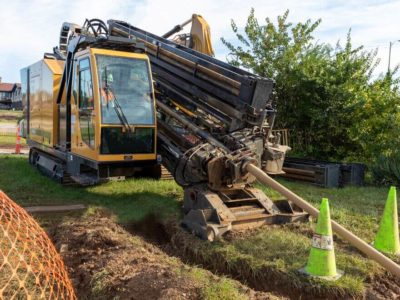Natural disasters like hurricanes, ice storms, derechos and tornadoes are leading causes of widespread power outages. During these weather events, utility crews scramble to restore the overhead lines as quickly as possible because so many of our basic living needs depend on electricity. This is just one reason so many utility companies are beginning to harden their grids by committing to undergrounding power lines. The need to expand and create a more resilient electrical grid is even more critical with the growth of electric vehicles (EVs) and the emergence of renewable energy from solar and wind sources.
“Relocating power lines from overhead to underground is not a new concept,” said Andy Bremner, Vermeer Pipeline sales manager. “The cost-per-foot (cost-per-meter) of undergrounding power lines is significantly higher than stringing traditional high lines. However, with the recent outages and the need to mitigate forest fires, utilities and the communities they serve are realizing that undergrounding some transmission and distribution infrastructure can help limit power outages and potentially extend maintenance intervals.”
Several utilities across the United States are investing heavily to relocate power lines from overhead to underground. Dominion Energy and WEC Energy Group are currently undergrounding more than 6,000 mi (9,656.1 km) of power lines combined. In 2021, PG&E set a goal to underground more than 10,000 mi (16,093.4 km) of overhead electrical lines in High Fire Threat Districts (HFTD) to further harden its system and help prevent wildfires. In addition, there is $73 billion earmarked to modernize the nation’s electrical grid in the U.S. Bipartisan Infrastructure Law.
Methods of undergrounding electrical lines
“A few U.S. utility companies have been actively working at relocating electric distribution lines for several years, while many others are just getting started,” explained Bremner. “With miles of distribution lines in their territories, it’s going to take robust long-term investment to transition overhead lines to underground. Utilities are also committed to undergrounding new transmission lines for hydropower and other renewables. For example, a large transmission project in New York with a significant number of lines underground will create opportunities for HDD contractors in the near future.”
Bremner went on to say that utilities are planning to use a combination of open-cut and trenchless installation methods.
“Open-cut installation with trenchers or excavators is possible in rural areas where there are no issues with above-ground obstacles for undergrounding power lines. In areas with more dense populations where there are many obstacles and structures, horizontal directional drilling (HDD) is a less intrusive method to surrounding communities and their essential infrastructure,” he said.
“We’re seeing many utility companies use 100,000-lbs (45,359.2-kg) HDDs and larger for undergrounding power lines,” said Bremner. “We have customers installing bundles of conduit or a single HDPE conduit that will house the high-voltage cable. We are seeing more maxi installations because they want to drill longer distances or larger diameter holes to accommodate the volume of grout needed to manage heat dissipation. Also, longer bores help minimize the number of duct banks and vaults that need to be constructed.”
After the conduit is in the ground, crews will construct duct banks/vaults. Then, they’ll backfill trenches, pull cable through the casings, insulate/grout the pipes and restore the site. In many cases, separate subcontractors are responsible for each project phase.
Opportunities for underground contractors
Undergrounding power lines is the next big growth market for underground contractors.
“As the world became more dependent on faster internet speeds, telecom companies and governments started installing fiber rapidly,” said Bremner. “Undergrounding power lines have similar potential for contractors, but the equipment size may differ in many cases. Utility-sized HDDs and trenchers will work fine for short distances and small product bundles. But, to handle larger diameter electrical transmission and distribution lines will require maxi rigs and large-diameter trenchers and contractors with expertise doing more complicated installs.”
Bremner, the team at Vermeer and its network of dealers are in constant communications with utility contractors to stay in tune with the level and type of support they need today and in the future.
“We are ready to partner with contractors pursuing the overhead-to-underground opportunity with equipment, tooling, parts, service and training at the local level,” said Bremner. “For utility companies to provide a resilient, sustainable power delivery network, it will require absolute alignment among contractors, design engineers, regulatory authorities, equipment manufacturers and local communities.”
To help do your part in hardening the grid, keep your eye out for opportunities that fit your company’s skill set. You can do that by monitoring the news, contacting local utility companies and talking with your Vermeer dealer.
“Creating a resilient power grid that can meet future energy demands is a huge undertaking that will require the expertise of many people in the underground construction industry. Exciting times are ahead of us,” concluded Bremner.
Vermeer Corporation reserves the right to make changes in engineering, design and specifications; add improvements; or discontinue manufacturing at any time without notice or obligation. Equipment shown is for illustrative purposes only and may display optional accessories or components specific to their global region. Please contact your local Vermeer dealer for more information on machine specifications.
Vermeer and the Vermeer logo are trademarks of Vermeer Manufacturing Company in the U.S. and/or other countries. © 2023 Vermeer Corporation. All Rights Reserved.
